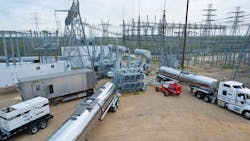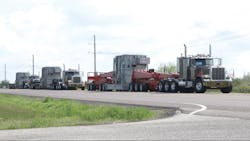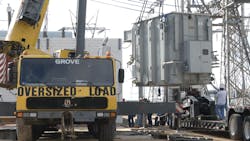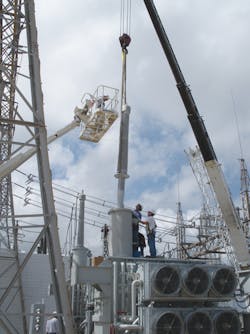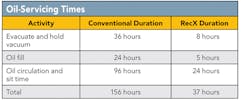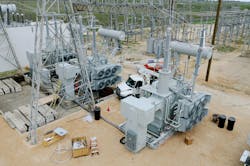Ready to Roll: Training for Disaster Recovery
The U.S. electric utility industry has a long track record of reliability. Long-term outages are rare, but serious outage events can pose a threat to the economy as well as national security. As demonstrated by Hurricane Sandy’s rampage up the Eastern Seaboard in 2012, the economic cost of sustained power outages can quickly run into billions of dollars, as approximately 60% of America’s gross domestic product is directly tied to electric power. The societal cost is potentially far higher. America depends on its critical energy infrastructure for food, water, transportation, communications and more.
Electric utilities have spent billions of dollars and made huge strides toward strengthening their systems against natural disasters as well as man-made attacks. However, the fact remains the geographic and physical nature of these networks makes them vulnerable targets. The second line of defense, therefore, is rapid recovery from an outage, which is the goal of the Rapid Recovery Transformer (RecX) program.
Ready to Roll
The RecX program consists of a consortium of the Electric Power Research Institute (EPRI), the U.S. Department of Homeland Security Science and Technology Directorate (DHS S&T), transformer manufacturer ABB Inc., and Houston, Texas, U.S.-based transmission and distribution utility CenterPoint Energy. The consortium developed a prototype transformer that could conceptually replace a failed extra-high-voltage (EHV) transformer in about a week as opposed to several months.
But could it really be done? Could a trio of single-phase 200-MVA, 345/138-kV autotransformers be disassembled, loaded onto over-the-road trailers, transported 900 miles (1,448 km), reassembled and energized in less than one week? To answer that question, an installation drill was planned and conducted by the consortium in March 2012, with CenterPoint Energy serving as host utility.
The drill began at 8:05 a.m. on Monday, March 12 at the ABB manufacturing plant in St. Louis, Missouri, U.S. The partially assembled units were pulled from storage, simulating an actual emergency scenario. ABB personnel drained oil from the units to reduce the shipping weight and two of the smaller, more easily transportable transformers were disassembled and loaded onto conventional lowboy trailers for the trip to Houston. The third unit was disassembled and loaded onto a 65-ton capacity trailer (MA65) specially designed for the project. The MA65 resembles an over-the-road Schnabel railcar and proved to be an amazingly versatile heavy hauler.
Also prepared for the trip to Houston were six 18-wheel flatbed trailers (two trailers per unit) loaded with ancillary equipment and three oil tankers containing 5,700 gal (21,577 l) of oil each, one tanker per unit. Obtaining transportation permits for loads this size takes hours versus weeks for permitting heavier units, which require states to perform road- and bridge-capacity studies.
Preparation and Testing
CenterPoint Energy personnel began preparing an existing EHV three-phase autotransformer position for arrival of the transformers. However, to prove the emergency response concept, minimal preparations were allowed by drill monitors from the Idaho National Laboratory. Preparations included test and checkout of existing low- and high-side breakers and switches, test and checkout of relay panels, installation of two wood transmission poles to support the rerouting of primary conductors and layout of crane mats. Furthermore, primary conductors were measured and cut to length but not installed. Site preparation outside the oil-containment basin was minimal because of the sled attached to the third unit for use with the MA65 trailer.
The ancillary equipment trailers arrived in Houston early Tuesday morning. Each equipment trailer had been meticulously mapped and loaded using input from those who would load the equipment, those who would transport it, those who would unload it and those who would test it prior to assembly. Pieces were unloaded and carefully staged for test and assembly. Testing of lightning arresters, bushings, current transformers and each unit’s self-contained power modules began immediately.
Soon after the ancillary equipment trailers, the oil tankers arrived. A full battery of oil tests ensued. Transformer trailers arrived in Houston late Tuesday afternoon. Two of the 125,000-lb (56,700-kg) units were positioned atop the existing foundation by a crane, which is a common practice at CenterPoint Energy. The third unit was positioned just outside the oil-retention basin of the existing foundation by the MA65 trailer. The MA65 trailer’s hydraulics and maneuverability made quick work of setting the third unit in place.
On-the-Clock Assembly
On Wednesday morning, assembly began. With the exception of oil-servicing personnel, the assembly crews worked 12-hour to 14-hour days. Each crew member (of the 35 total) was an experienced CenterPoint Energy substation technician and had sequentially coordinated tasks to perform within specific time frames. Had this been an actual emergency, the crews probably would have worked around the clock. In this case, the team thought the plan to use valuable daylight and available support services during normal hours and was free of time-wasting shift hand-off issues. The level of activity reminded one observer of ants methodically repairing a disturbed anthill.
The modular design of the transformers and components enabled quick assembly of the units. Further, the draw-rod bushing design precluded the need for personnel to enter the main tank of the transformers to connect bushings. This minimized the introduction of moisture and potential introduction of other debris into the main tank compartment. By Wednesday evening, oil servicing began simultaneously on all three units. Because of the size of the units and the relatively short time the core and windings were without oil, the oil-servicing time was reduced to less than one-quarter that of a conventional unit.
With oil processing complete, primary connections were made using double 795-kcmil conductors and double 2,000-kcmil conductors on the 138-kV side. This involved sagging low-side conductors over the two foundation-mounted units. The high-side and low-side conductors were routed over the outside unit using the two wood poles, set prior to the arrival of the transformers.
By late Friday evening, the project was near completion and a decision had to be made: Should workers push into the night and early morning to do final checks, or should they come back fresh on Saturday morning? The decision was made to return on Saturday morning, and it turned out to be the appropriate one. The usual commissioning issues, including a damaged sudden-pressure relay connector, held the project up for nearly four hours. Units were successfully energized with load at 6:15 p.m. on Saturday evening — 5 days, 10 hours and 10 minutes after the simulation had started. Then at that point, the clock started on the in-service trial period of one year. The one-year trial period was selected in association with the time estimated to obtain a permanent replacement in an actual emergency scenario.
One Year Later
Monitoring of the transformers is state of the art. Each unit is equipped with on-line dissolved gas monitoring as well as ABB’s TEC intelligent cooling control and data logger, which uses fiber-optic hot-spot temperature monitoring technology. The units have functioned well over the past year. Units were scheduled for outages several times since being energized, once to revise primary grounding, three times to revise tertiary station service grounding and once to test the modular remote oil cooler feature.
Loading has been a challenge because the 14% impedance of the RecX is twice that of the three autotransformers operated in parallel with the RecX. Hence, the units have not been loaded to more than half their capacity since the installation. Moreover, because the RecX units do not have tap changers, the load tap changers of parallel units must be blocked to control circulating current.
The RecX prototype is designed to replace the most common EHV transformer in the U.S. utility power fleet — a 345/138-kV autotransformer. According to the team’s analysis, the RecX design is a suitable replacement in the event of an emergency to more than 90% of the transformers in its voltage class. Next steps for the project are to review the design, applicability and logistics based on lessons learned from the drill and industry input. Conceptually, RecX transformers could be stored at various secure regional locations, designed to the specific voltage levels used in each region and rapidly deployed when needed. EPRI and other stakeholders are working to analyze more innovative approaches to transition the recovery transformer concept to industry.
Good Work Recognized
The RecX project was an exciting one for CenterPoint Energy. Working with the DHS S&T, EPRI and ABB was a positive experience. The project was an opportunity for success by all the participants. CenterPoint Energy also was pleased with the opportunity to showcase its transformer team. Of course, it is hoped the type of event this drill represented will never actually happen. But, it is comforting to know that, if it does happen, the plan, the equipment and the skills to quickly return to some semblance of normal are in place.
For its work with this project, CenterPoint Energy received an EPRI Technology Transfer award in February 2013. Then in June 2013, the utility was distinguished with the South-eastern Electric Exchange Substation Industry Excellence award.
Acknowledgment
The author acknowledges contributions from several organizations in the planning and success of this endeavor. These contributors include Clay Perry and Rich Lordan of the Electric Power Research Institute; Craig Stiegemeier of ABB also provided critical planning leadership and support. The leadership, motivation and encouragement provided by Project Lead Sarah Mahmood from the DHS S&T were key to the project’s success. Also, DHS provided the photographs used in this article. The CenterPoint Energy crew that accomplished this drill was remarkable and led by KC Jones. Noteworthy internal engineering support for the project was provided by Bert Crego, Don Sevcik and Lee Talley.
Jack Heintschel Jr. ([email protected]) is an operations manager in the substation performance division of CenterPoint Energy’s Houston Electric organization with 38 years in the electric utility business. His current responsibilities include oversight of the division’s transformer service and repair group, diagnostics group, substation training group and substation administrative staff. Heintschel coordinates the recruiting and hiring process for CenterPoint Energy’s substation technicians and holds a bachelor’s degree in electrical technology from the University of Houston.
Companies mentioned:
ABB | www.abb.com
CenterPoint Energy | www.centerpointenergy.com
DHS S&T | www.dhs.gov/st-organization
EPRI | www.epri.com
INL | inl.gov
